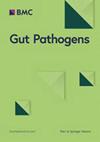埃塞俄比亚哈瓦萨市医院消化不良患者幽门螺杆菌感染率和一线三联根除疗法的有效性:横断面随访研究
IF 4.3
3区 医学
Q1 GASTROENTEROLOGY & HEPATOLOGY
引用次数: 0
摘要
消化不良是一种常见的胃肠道疾病,有时与幽门螺旋杆菌(H. pylori)感染有关。筛查和根除幽门螺杆菌可降低感染相关并发症的风险。本研究旨在确定埃塞俄比亚哈瓦萨市医院消化不良患者中幽门螺杆菌感染的程度以及三联根除疗法的效果。幽门螺杆菌感染率为 48.5%。采用一线三联疗法的幽门螺杆菌根除率为 83.8%。根除治疗失败与以下因素有关:以前接触过幽门螺杆菌而没有接触过(AOR:4.8,95% CI:1.37-10.97);疗程为 10 天而不是 14 天(AOR:4.05,95% CI:1.42-11.55);自我报告有副作用而没有报告(AOR:2.5,95% CI:1.12-5.97)。根据莫里斯基八分法,230 名患者(79.0%)坚持了三联疗法。与有不良反应报告的患者相比,没有不良反应报告的患者坚持三联疗法的几率更高(AOR = 2.45,95% CI:1.29-4.62)。这项研究表明,约有一半的成人消化不良患者感染了幽门螺杆菌,并观察到了中等程度的根除效果。既往根除治疗史、根除治疗方案的持续时间以及对潜在不良反应的感知等因素与根除率有关,在开始根除治疗时应加以考虑。本文章由计算机程序翻译,如有差异,请以英文原文为准。
Prevalence of Helicobacter pylori infection and effectiveness of first-line triple eradication therapy among dyspeptic patients at hospitals in Hawassa City, Ethiopia: a cross-sectional follow-up study
Dyspepsia is a common gastrointestinal illness sometimes associated with Helicobacter pylori (H. pylori) infection. Screening and eradicating the bacterium reduces the risk of infection-related complications. The aim of this study was to determine the magnitude of H. pylori infection among dyspeptic patients and the effectiveness of triple eradication therapy at hospitals in Hawassa city, Ethiopia. The prevalence of H. pylori infection was 48.5%. The H. pylori eradication rate using first-line triple therapy was 83.8%. Eradication therapy failure is associated with previous exposure compared to no exposure (AOR: 4.8, 95% CI: 1.37–10.97), a regimen for 10-days compared to 14-days (AOR: 4.05, 95% CI: 1.42–11.55), and self-reported side effects compared to no report (AOR: 2.5, 95% CI: 1.12–5.97). Based on Morisky-eight scale 230 (79.0%) patients were adherent to their triple therapy. Participants with no reports of adverse effects showed increased odds of adherence to triple therapy compared to those who had reports (AOR = 2.45, 95% CI: 1.29–4.62). This study demonstrated that about half of adult dyspeptic patients were infected with H. pylori, and moderate eradication was observed. Factors such as previous history of eradication therapy, duration of the eradication regimen, and perception of potential adverse effects are associated with eradication rate and should be considered during the initiation of eradication therapy.
求助全文
通过发布文献求助,成功后即可免费获取论文全文。
去求助
来源期刊

Gut Pathogens
GASTROENTEROLOGY & HEPATOLOGY-MICROBIOLOGY
CiteScore
7.70
自引率
2.40%
发文量
43
期刊介绍:
Gut Pathogens is a fast publishing, inclusive and prominent international journal which recognizes the need for a publishing platform uniquely tailored to reflect the full breadth of research in the biology and medicine of pathogens, commensals and functional microbiota of the gut. The journal publishes basic, clinical and cutting-edge research on all aspects of the above mentioned organisms including probiotic bacteria and yeasts and their products. The scope also covers the related ecology, molecular genetics, physiology and epidemiology of these microbes. The journal actively invites timely reports on the novel aspects of genomics, metagenomics, microbiota profiling and systems biology.
Gut Pathogens will also consider, at the discretion of the editors, descriptive studies identifying a new genome sequence of a gut microbe or a series of related microbes (such as those obtained from new hosts, niches, settings, outbreaks and epidemics) and those obtained from single or multiple hosts at one or different time points (chronological evolution).
 求助内容:
求助内容: 应助结果提醒方式:
应助结果提醒方式:


